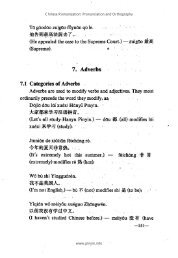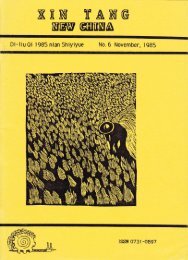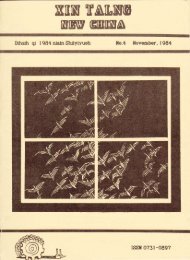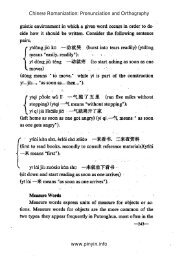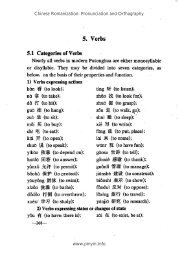XIN TANG (New China) - Pinyin.info
XIN TANG (New China) - Pinyin.info
XIN TANG (New China) - Pinyin.info
- No tags were found...
You also want an ePaper? Increase the reach of your titles
YUMPU automatically turns print PDFs into web optimized ePapers that Google loves.
21 KIN <strong>TANG</strong>: NEW CHINAclean break with classical Chinese. however. <strong>China</strong>'sintellectuals, especially academics, have settled for aHybrid Baihua. This style of writing is so riddled withclassical remnants that it is incapable of simple phonetictranscription. As a result, far from paving the way foralphabetic writing. it actually constitutes a major barrierto such a basic reform in the script.<strong>China</strong>'s second lost opportunity came with theestablishment of the PRC in 1949. At that time manyreformers confidently expected to see the implementationof alphabetic writing as advocated earlier by MaoZedong and others. Instead the leaders of new <strong>China</strong>vacillated and temporized on this issue. As a resultopposition is now so deeply entrenched that languagereformers have resigned themselves to a long hardstruggle. Rejecting any talk of -abandoning- characters,they urge instead a policy of what may be called digraphi ••of promoting two co-existing orthographies, charactersand <strong>Pinyin</strong>, each to be used in the areas for which it is bestsuited.The lost opportunity for Japan came in 1946. In thespring of that year a U.S. Education Mission sent to adviseMcArthur recommended the replacement of the lYmii-basedwriting in favor of romlii. Japanese language reformers,previously hounded, jailed and even murdered by therepressive pre-war regime, sprang to the support of thechange, and an important segment of the general publicgave some evidence that it might also lend its approval.But McArthur vetoed this basic reform. Any demand forextensive change was further forestalled by the decisionof the educational bureaucracy to give way slightly in thedirection of limiting the number of Qnii. to less than twothousand. In recent years kIDa has achieved widespreaduse in computer technology. as well as in everyday<strong>info</strong>rmal use, and romaii has shared a role in computerswhile being used exclusively in telex. Despite these



